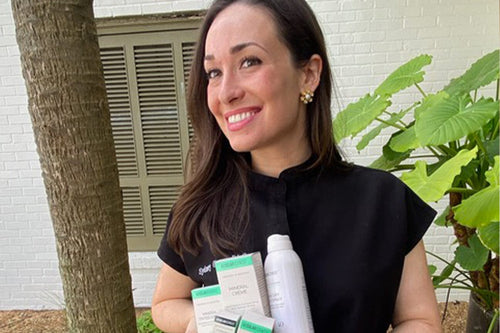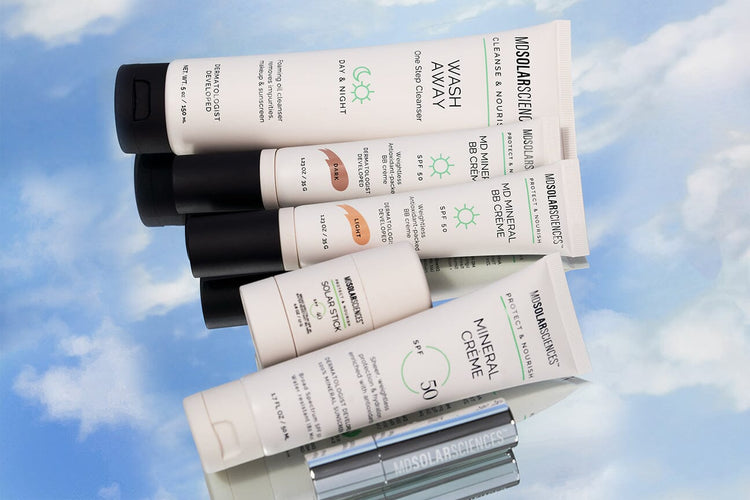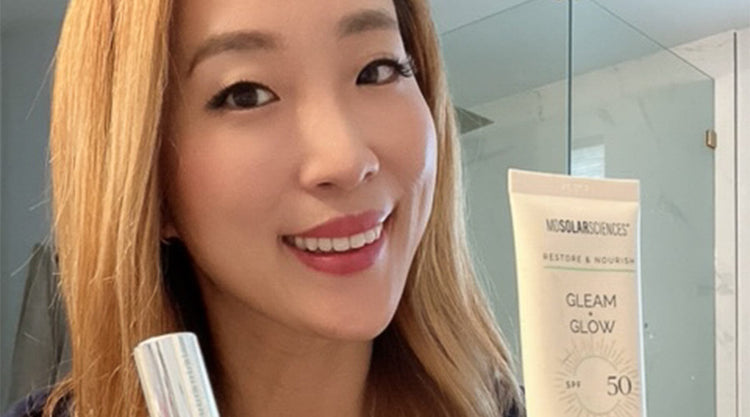Your Expert Guide To Skin Cancer
We sat down with Dermatologic PA Sydney Givens, a member of our SHE (Skin Health Exchange) council to find out everything you need (and want) to know about protecting your skin, preventing skin cancer, and detecting signs of abnormality.
Your questions, answered…
Q:
Why is it important to incorporate SPF into your daily skincare routine?
A:
The sun is the main cause of wrinkles, brown discoloration, and of course skin cancer. Sunscreen protects against these harmful UV rays. Look for a broad-spectrum sunscreen to protect against both UVA (aging) and UVB (burning/skin cancer) rays.
Q:
What are the most important steps in preventing skin cancer?
A:
Sun exposure is the most common cause of skin cancer; the number one step is to protect your skin from the sun. I’ve found most of us have to change our habits For example, there’s not enough sunscreen to be in the sun for hours without some sort of shade- an umbrella, wide-brimmed hat, long-sleeved clothing UPF or even without to cover your exposed skin regardless of the weather forecast.
Of course, start the day with an SPF of at least 30. If it’s a chemical sunscreen, meaning avobenzone is the SPF ingredient, make sure to apply 20 minutes BEFORE going into the sun. If you’re using a mineral sunscreen (aka physical meaning zinc oxide or titanium oxide), then you are good to go as soon as you walk out the door!
Every year, go to your local dermatology office for a skin exam, but at home, you should also get to know your body! Perform regular skin checks. Familiarize yourself with lesions on your skin, especially brown, flat moles so that you know when there is a change in a lesion or there’s a new lesion.
Do I need to say avoid tanning beds? That is a personal choice, but just so you can weigh the risks in your decision, here is how I explain it to patients: cigarettes and lung cancer are like tanning beds to melanoma (the really dangerous and fast-growing skin cancer). Do what you want with that information and know while tanning beds don’t have a direct 100% correlation there is research that shows it increases the risk greatly. Plus, cosmetically, it really increases the onset of aging skin.
On that note, consider avoiding smoking since it has been linked to an increased risk of certain types of skin cancer. By taking these steps, you can significantly reduce your risk of developing skin cancer and promote overall skin health.
Q:
How has the number of patients with skin cancer changed within the past few years?
A:
According to the American Cancer Society, the incidence of skin cancer has been increasing over the past few decades. In 2021 in the U.S. alone there was an increase in melanoma by 200,000+ new cases and 100,000+ new cases of non-melanoma skin cancer (basal cell carcinoma and squamous cell carcinoma).
This could partially be attributed to increased awareness as well as noting that the COVID-19 pandemic delayed preventive skin cancer exams and treatments in the timeframe of that data.
I also think an increase in focus on skincare has made visiting a dermatology office more mainstream at least for cosmetic reasons, and we often find abnormal lesions at those appointments or a follow up appointment.
Q:
Are there any symptoms / red flags of skin cancer that are less discussed that may help its diagnosis?
A:
Yes, there are some lesser-known symptoms and red flags of skin cancer that are important to be aware of for early detection and diagnosis. Start by knowing which lesions are normal on your skin. During a skin check at a dermatology office the medical provider should educate you on what to monitor on your skin. Generally any lesions that do not heal completely should be evaluated.
Here are some examples of symptoms to know:
- Scaliness or crusting: Some types of skin cancer, such as squamous cell carcinoma, may cause rough, scaly patches or open sores that don't heal.
- Bleeding: Basal cell carcinoma bleeds easily and often mimics a pimple that doesn't heal, but persists as a crusty bump.
- Changes in shape, pigment, or size of brown, flat mole: close your eyes and rub your finger over a mole. The ones that you CANNOT feel are ones to monitor for the ABCDEs: Asymmetry, irregular Borders, multiple Colors/shades of brown, black, blue, pink, white, in one lesion, Diameter larger than a pencil eraser. The most important one is Evolution - "have they changed?"
- Itching, tenderness, or pain: Most skin cancers don't cause any pain or discomfort, but in some cases, they can be accompanied by itching, tenderness, or pain.
- Nail changes: Skin cancer can develop under the nail bed, causing changes in the color or texture of the nail. For example, a brown or black streak under the nail that doesn't go away could be a sign of melanoma.
- Rapid growth: Skin cancer that grows quickly or changes rapidly in size, shape, or color can be a cause for concern.
Lastly, know if you have a family history of melanoma in your first degree relatives, meaning a parent or sibling.
These are not definitive signs of skin cancer, and many of them can be caused by other conditions. However, if you notice any of these changes in your skin, it's important to consult a healthcare professional for a proper diagnosis and treatment.
Q:
Can skin cancer be cured?
A:
In many cases, skin cancer can be cured if it is detected and treated early enough. The answer depends on several factors, such as the type of skin cancer, its stage, location, and other individual factors.
While a particular lesion many times is easily removed with an excision or MOHS surgery, it doesn’t mean you won’t develop another skin cancer of either the same or different type in another area or adjacent area.
After a skin cancer diagnosis the standard of care is to follow up every 3-6 months for about 2 years so we can regularly check your skin for recurrences.
Q:
Can skin cancer spread?
A:
Melanoma, the most dangerous type of skin cancer because it grows rapidly and has a higher risk of spreading or metastasizing to other parts of the body than other types of skin cancer. If melanoma is detected and treated early, it has a very high cure rate.
However, if it is not treated early and has the opportunity to spread, it can be life-threatening.
The other two most common types of skin cancer- basal cell carcinoma and squamous cell carcinoma will not necessarily spread and can be successfully treated if detected early.
It can seem like they spread to patients because there is an increased chance of having other skin cancers in the first 2 years after a skin cancer diagnosis. I like to explain that this is because skin cancers occur when our genetics and past sun damage hit the exact right threshold to occur so when that happens once there’s an increased chance it will reoccur soon after and commonly in the same area.
Q:
What are the most essential skincare products you should have in your routine?
A:
The skincare trifecta includes daily sunscreen with SPF30+, a retinoid or chemical exfoliator at night, and antioxidants in the morning- think vitamin C serum. Using products with these ingredients daily is the foundation to treating all skincare concerns. You’ll see immediate improvement in texture and radiance by implementing these 3 simple steps.
Q:
What's the best sunscreen for kids/babies?
A:
Hands down the MDSS Kids Crème is the best. It’s 100% mineral, but has an elegant texture that easily spreads and everyone enjoys applying. It’s proof that mineral sunscreens, the best thing for our bodies, don't have to come with the unpleasant white, pasty texture. It’s also best sunscreen during pregnancy.
I also enjoy and recommend having multiple methods of SPF application- a sunscreen stick for ears, face, and reapplication every 2 hours as well as sunscreen spray makes life easy!
SHOP NOW




